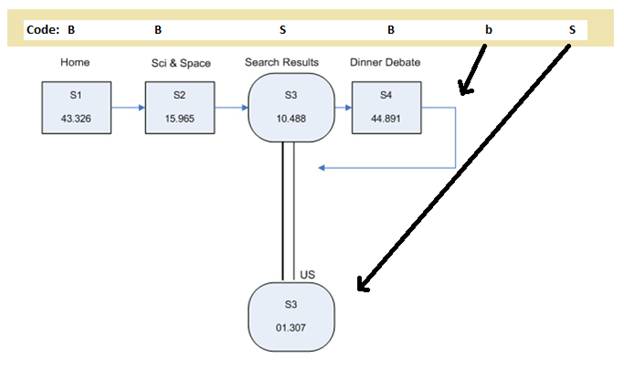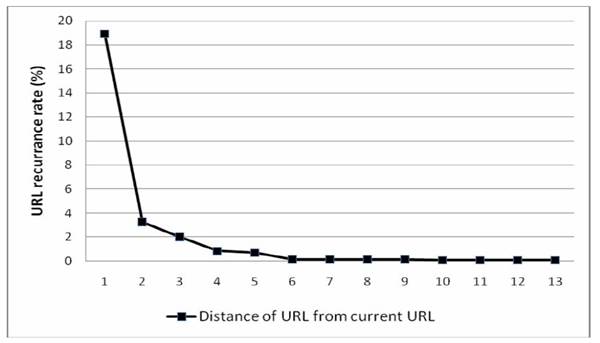- About us
- Contact us: +1.641.472.4480, hfi@humanfactors.com
Cool stuff and UX resources
Introduction
Do your end-users engage in "information foraging"?
Well, another way of asking that question is "To what degree is your organizational intranet site like a news site?"
- Do you want to keep employees updated about organization wins? (Build morale!)
- Is it important that your colleagues at work be able to converse intelligently about "what's happening at work" in their B2C and B2B conversations? (Build knowledge!)
If yes, to either of the above, then your intranet serves a "news" function.
- And while we're at it, let's include other news-offering websites such as "corporate identity" sites or even news sites. (Build customers!)
Given this focus, what usability methods offer you the best insights into how end-users forage for information?
We can continue with the same old "think out loud" and web analytics methods. They work.
But can we also find new methods of characterizing interaction with information foraging tasks?
This is the question addressed by our researcher, William Gibbs, Associate Professor of Journalism and Multimedia Arts at Duquesne University in Pittsburg, PA.
I found his research particularly interesting because he wanted...
"insight into new uses and incarnations of web devices and applications... This is especially important for news provider websites where users are actively seeking content that changes on a moment-to-moment basis."

New methods show "home is where the heart is"
Gibbs evaluated 6 news sites using a variety of old and new methods along with the think-aloud method. He looked at cnn.com, foxnews.com, msnbc.com, nytimes.com, usatoday.com, and post-gazette.com.
His new methods include six approaches to what he calls "information seeking behaviors", which we will describe below.
But first, what did he find in his detailed analysis of 8 participant's "information seeking"?
NOTE: half received a "directed task" (find two top news stories about an environmental issue); half received a "semi-directed task" (browse each site freely for interesting stories).
1) Question: when presented with many links on a news site home page, do people search or browse?
Answers: All participants browsed! The directed participants browsed for a minute, then searched. The semi-directed participants pretty much just browsed.
Recommendation: Support browsing on your news home page. "Home is where the heart is."
2) Question: will people scroll a long home page?
Answer: Yes. People scrolled in both tasks.
Recommendation: Scrolling can work if the page looks like a news page. "Home is where the heart is."
3) Question: Does web experience govern willingness to depart far from the home page or search results page?
Answer: No. Regardless of their prior web experience, all news-site visitors tend to only jump 1 page away, then come back right away.
Recommendation: Spend money on your home page and search results design. "Home is where the heart is."
What methods of measuring "information foraging" allowed Professor Gibbs to clearly see these and other findings?
The starter kit: Basic measurements
Professor Gibbs explains that he recorded participant interaction using Morae, a digital recording tool. Standard Morae measurements gave the following outcomes for 31 participants.
- Average time per task: 4 minutes ‚Äď Home page visited for 45 seconds on average. Directed tasks took 3 seconds longer than semi-directed tasks.
Conclusion: You have 4 minutes of "ad exposure" regardless of task type. Don't worry about task type.
- Average number of clicks: 18 ‚Äď 17 for semi-directed tasks; 19 for directed tasks.
Conclusion: People exert the same effort regardless of task type. Don't worry about task type.
- Back button: 8% of all navigation events ‚Äď Average of 11 Back-clicks for directed tasks; 7 for semi-directed tasks. (Other research shows the Back button can account for 30% to 40% of navigation.)
Conclusion: Without clear jump back to Home, directed tasks foster a sense of "back-tracking" the exact path and adds to subjective effort.
- Search: 96% ‚Äď out of 82 searches ‚Äď occurred after participants browsed an average of 67 seconds during directed task.
Conclusion: Design for browsing, even when you expect people to search.
Advanced method #1: Code user actions (log "info seeking trails")
Professor Gibbs borrows from the play-book of other researchers. This approach seeks to characterize each participant's actions through "coding" of each action by the researcher. This first example is a simple case of describing a "trail" through a sequence of pages.
Here, Professor Gibbs wants to show what he calls "information seeking trails" ‚Äď namely, how much time does the end-user spend doing the following (I give the coding here):
| Code | Behavior | Description |
|---|---|---|
| B | Browse | Viewing a page on the click-path flowing away from the start point |
| S | Search | Use of a site's search facility |
| f | forward | Clicking a hyperlink to a page not previously visited (this action is typically assumed and thus not labeled except for training, below) |
| b | backward | User revisits a page on the trail |
Sample use of this nomenclature. You could memorize this for your usability test notations.
| Code | If the user were to... |
|---|---|
| B | Browse the opening page, |
| f | then navigate forward to new page to... |
| B | Browse the second page, |
| f | then navigate forward to new page to... |
| S | use the Search page, |
| f | then navigate forward to a new page to... |
| B | Browse the new page |
| b | then navigate back to the prior page (the search page)... |
| S | another Search |
As a convention, this method assumes all transitions are "f" (forward). Therefore, for greater ease, Prof Gibbs suggests the above could be written as follows (dropping the "f"):
B B S B b S
Now that you have this notation, Prof Gibbs suggests you can show how one task might contrast with a re-design of that task. For example, here are the two designs using this "information seeking trails" nomenclature.
| Your Coded "Info Seeking Trail" | Implication |
|---|---|
| B B S B b S   ("Before your redesign") | This "information seeking trail" shows that the search result entry failed to communicate the content of the Browse page, requiring a return to the Search page. |
| B B S   ("After your redesign") | This second "trail" demonstrates the reduced navigation results from improved search results descriptions. |
Here is an example of how your notation could be diagrammed, including the average number of seconds on each page. The timing would come from a time-stamp tool or digital recorder like Morae.
For an alternate approach, Professor Gibbs aggregated "information seeking trail" data from 8 participants for the six news websites, as follows. He characterized the interaction using percent of interactions devoted to the following categories:
| (B) Forward to Browse | (b B) Backward to Browse | (S) Forward to Search | (b S) Backward to Search |
|---|---|---|---|
| 69% | 19% | 5% | 7% |
Different designs will result in different findings. For example, other research shows 21% of interactions as "forward-to-search". If this were on a news site, then we could predict that the ad-revenue will be less than on the current sites. This is because with a higher percentage of searches, fewer pages get seen.

Advanced method #2: Web page recurrence
Other researchers have found that some pages on a site get lots of visits (e.g., Home and Search) while other pages get few visits. The best predictor of a "revisit" is the recency with which the page was last visited.
| Total pages visited | Unique pages visited | Recurrence rate | |
|---|---|---|---|
| All Users | 1472 | 1069 | 27% |
| Directed | 707 | 491 | 31% |
| Semi-directed | 765 | 537 | 30% |
Gibbs used this formula to calculate the "Recurrence Rate"
R =(Total URLS visited minus Unique URLS visited) divided by Total URLS visited
Example, for All Users
(1472 - 1069) / 1472 = 27.37% Recurrence Rate of visits
This means that 27% of page visits are repeat visits (non-unique visits). If you are selling ad views, are you getting paid for repeat visits? Furthermore, does a high rate of recurrence or repeat visits indicate that your site visitors find navigation difficult?
While the data can point out these questions, in most cases, you must utilize the "think-aloud" technique to get your insights. See Jenkins, Corritore, and Wiedenbeck, 2003 (cited below) for more examples of information-seeking behaviors on the web.

Conclusion: Advanced methods allow advanced site invention
We have looked at three out of about 6 advanced methods Professor Gibbs offers in his paper. Check his paper (below) to see the others.
In certain cases, the methods have revealed differences between directed task and semi-directed tasks. Semi-directed tasks tended to cause end-users to engage in more scrolling, scan more advertisements with their mouse and click on more images compared with the directed tasks.
This is logical. "Directed tasks" mean the end-user has a specific question to answer. Time is money, so they are less inclined to explore.
Therefore, directed tasks were associated with searching (but, remember, after 67 seconds devoted to browsing). Also, directed task end-users tended to use their mouse to scan links while scrolling down a page.
Professor Gibbs indicates that end-users with directed tasks show focused behaviors that are less open to reading ads than participants doing semi-directed tasks. Therefore, the semi-directed end-user is a better candidate for advertising.  He speculates that their behaviors can be detected by a "smart browser" (the presence or absence of mouse movements can be picked up) "and based on their behaviors, the browser displays, highlights, or repositions ads, making them more prominent."
This may be an opportunity to personalize sites based on browsing behaviors. Is your organization interested in heart-pounding "hanging ten" on the surf-board of advanced site development?
Home is where the heart is...
All said, this research verifies how your expectations should vary according to the purpose of your site. If your site indeed has a large component of "news" as a mission, then consider how to make the home page a strong page for revisitation.
Recall, "recurrent URLs" for a news site can mean different things. Therefore, you will need input from your test participants from their "think-aloud" comments.
Does a page revisit mean "I just didn't get it. The navigation was bad."?
Or does the page revisit mean "I love this page. It gets me to the news I want to see."
In both cases, your news-oriented Home page merits a lot of attention.
Are you putting your own heart into designing the page you want to call Home?
References
Gibbs, W.J., 2008. Examining Users on News Provider Web Sites: A Review of Methodology, Journal of Usability Studies, 3 (3), 129-148.
Jenkins, C., Corritore, C., and Wiedenbeck, S., 2003. Patterns of Information Seeking on the Web: A Qualitative Study of Domain Expertise and Web Expertise, IT & Society, 1 (3), 64-89
Message from the CEO, Dr. Eric Schaffer ‚ÄĒ The Pragmatic Ergonomist
Leave a comment here
Subscribe
Sign up to get our Newsletter delivered straight to your inbox
Privacy policy
Reviewed: 18 Mar 2014
This Privacy Policy governs the manner in which Human Factors International, Inc., an Iowa corporation (‚ÄúHFI‚ÄĚ) collects, uses, maintains and discloses information collected from users (each, a ‚ÄúUser‚ÄĚ) of its humanfactors.com website and any derivative or affiliated websites on which this Privacy Policy is posted (collectively, the ‚ÄúWebsite‚ÄĚ). HFI reserves the right, at its discretion, to change, modify, add or remove portions of this Privacy Policy at any time by posting such changes to this page. You understand that you have the affirmative obligation to check this Privacy Policy periodically for changes, and you hereby agree to periodically review this Privacy Policy for such changes. The continued use of the Website following the posting of changes to this Privacy Policy constitutes an acceptance of those changes.
Cookies
HFI may use ‚Äúcookies‚ÄĚ or ‚Äúweb beacons‚ÄĚ to track how Users use the Website. A cookie is a piece of software that a web server can store on Users‚Äô PCs and use to identify Users should they visit the Website again. Users may adjust their web browser software if they do not wish to accept cookies. To withdraw your consent after accepting a cookie, delete the cookie from your computer.
Privacy
HFI believes that every User should know how it utilizes the information collected from Users. The Website is not directed at children under 13 years of age, and HFI does not knowingly collect personally identifiable information from children under 13 years of age online. Please note that the Website may contain links to other websites. These linked sites may not be operated or controlled by HFI. HFI is not responsible for the privacy practices of these or any other websites, and you access these websites entirely at your own risk. HFI recommends that you review the privacy practices of any other websites that you choose to visit.
HFI is based, and this website is hosted, in the United States of America. If User is from the European Union or other regions of the world with laws governing data collection and use that may differ from U.S. law and User is registering an account on the Website, visiting the Website, purchasing products or services from HFI or the Website, or otherwise using the Website, please note that any personally identifiable information that User provides to HFI will be transferred to the United States. Any such personally identifiable information provided will be processed and stored in the United States by HFI or a service provider acting on its behalf. By providing your personally identifiable information, User hereby specifically and expressly consents to such transfer and processing and the uses and disclosures set forth herein.
In the course of its business, HFI may perform expert reviews, usability testing, and other consulting work where personal privacy is a concern. HFI believes in the importance of protecting personal information, and may use measures to provide this protection, including, but not limited to, using consent forms for participants or ‚Äúdummy‚ÄĚ test data.
The Information HFI Collects
Users browsing the Website without registering an account or affirmatively providing personally identifiable information to HFI do so anonymously. Otherwise, HFI may collect personally identifiable information from Users in a variety of ways. Personally identifiable information may include, without limitation, (i)contact data (such as a User’s name, mailing and e-mail addresses, and phone number); (ii)demographic data (such as a User’s zip code, age and income); (iii) financial information collected to process purchases made from HFI via the Website or otherwise (such as credit card, debit card or other payment information); (iv) other information requested during the account registration process; and (v) other information requested by our service vendors in order to provide their services. If a User communicates with HFI by e-mail or otherwise, posts messages to any forums, completes online forms, surveys or entries or otherwise interacts with or uses the features on the Website, any information provided in such communications may be collected by HFI. HFI may also collect information about how Users use the Website, for example, by tracking the number of unique views received by the pages of the Website, or the domains and IP addresses from which Users originate. While not all of the information that HFI collects from Users is personally identifiable, it may be associated with personally identifiable information that Users provide HFI through the Website or otherwise. HFI may provide ways that the User can opt out of receiving certain information from HFI. If the User opts out of certain services, User information may still be collected for those services to which the User elects to subscribe. For those elected services, this Privacy Policy will apply.
How HFI Uses Information
HFI may use personally identifiable information collected through the Website for the specific purposes for which the information was collected, to process purchases and sales of products or services offered via the Website if any, to contact Users regarding products and services offered by HFI, its parent, subsidiary and other related companies in order to otherwise to enhance Users’ experience with HFI. HFI may also use information collected through the Website for research regarding the effectiveness of the Website and the business planning, marketing, advertising and sales efforts of HFI. HFI does not sell any User information under any circumstances.
Disclosure of Information
HFI may disclose personally identifiable information collected from Users to its parent, subsidiary and other related companies to use the information for the purposes outlined above, as necessary to provide the services offered by HFI and to provide the Website itself, and for the specific purposes for which the information was collected. HFI may disclose personally identifiable information at the request of law enforcement or governmental agencies or in response to subpoenas, court orders or other legal process, to establish, protect or exercise HFI’s legal or other rights or to defend against a legal claim or as otherwise required or allowed by law. HFI may disclose personally identifiable information in order to protect the rights, property or safety of a User or any other person. HFI may disclose personally identifiable information to investigate or prevent a violation by User of any contractual or other relationship with HFI or the perpetration of any illegal or harmful activity. HFI may also disclose aggregate, anonymous data based on information collected from Users to investors and potential partners. Finally, HFI may disclose or transfer personally identifiable information collected from Users in connection with or in contemplation of a sale of its assets or business or a merger, consolidation or other reorganization of its business.
Personal Information as Provided by User
If a User includes such User’s personally identifiable information as part of the User posting to the Website, such information may be made available to any parties using the Website. HFI does not edit or otherwise remove such information from User information before it is posted on the Website. If a User does not wish to have such User’s personally identifiable information made available in this manner, such User must remove any such information before posting. HFI is not liable for any damages caused or incurred due to personally identifiable information made available in the foregoing manners. For example, a User posts on an HFI-administered forum would be considered Personal Information as provided by User and subject to the terms of this section.
Security of Information
Information about Users that is maintained on HFI’s systems or those of its service providers is protected using industry standard security measures. However, no security measures are perfect or impenetrable, and HFI cannot guarantee that the information submitted to, maintained on or transmitted from its systems will be completely secure. HFI is not responsible for the circumvention of any privacy settings or security measures relating to the Website by any Users or third parties.
Correcting, Updating, Accessing or Removing Personal Information
If a User’s personally identifiable information changes, or if a User no longer desires to receive non-account specific information from HFI, HFI will endeavor to provide a way to correct, update and/or remove that User’s previously-provided personal data. This can be done by emailing a request to HFI at hfi@humanfactors.com. Additionally, you may request access to the personally identifiable information as collected by HFI by sending a request to HFI as set forth above. Please note that in certain circumstances, HFI may not be able to completely remove a User’s information from its systems. For example, HFI may retain a User’s personal information for legitimate business purposes, if it may be necessary to prevent fraud or future abuse, for account recovery purposes, if required by law or as retained in HFI’s data backup systems or cached or archived pages. All retained personally identifiable information will continue to be subject to the terms of the Privacy Policy to which the User has previously agreed.
Contacting HFI
If you have any questions or comments about this Privacy Policy, you may contact HFI via any of the following methods:
Human Factors International, Inc.
PO Box 2020
1680 highway 1, STE 3600
Fairfield IA 52556
hfi@humanfactors.com
(800) 242-4480
Terms and Conditions for Public Training Courses
Reviewed: 18 Mar 2014
Cancellation of Course by HFI
HFI reserves the right to cancel any course up to 14 (fourteen) days prior to the first day of the course. Registrants will be promptly notified and will receive a full refund or be transferred to the equivalent class of their choice within a 12-month period. HFI is not responsible for travel expenses or any costs that may be incurred as a result of cancellations.
Cancellation of Course by Participants (All regions except India)
$100 processing fee if cancelling within two weeks of course start date.
Cancellation / Transfer by Participants (India)
4 Pack + Exam registration: Rs. 10,000 per participant processing fee (to be paid by the participant) if cancelling or transferring the course (4 Pack-CUA/CXA) registration before three weeks from the course start date. No refund or carry forward of the course fees if cancelling or transferring the course registration within three weeks before the course start date.
Cancellation / Transfer by Participants (Online Courses)
$100 processing fee if cancelling within two weeks of course start date. No cancellations or refunds less than two weeks prior to the first course start date.
Individual Modules: Rs. 3,000 per participant ‚Äėper module‚Äô processing fee (to be paid by the participant) if cancelling or transferring the course (any Individual HFI course) registration before three weeks from the course start date. No refund or carry forward of the course fees if cancelling or transferring the course registration within three weeks before the course start date.
Exam: Rs. 3,000 per participant processing fee (to be paid by the participant) if cancelling or transferring the pre agreed CUA/CXA exam date before three weeks from the examination date. No refund or carry forward of the exam fees if requesting/cancelling or transferring the CUA/CXA exam within three weeks before the examination date.
No Recording Permitted
There will be no audio or video recording allowed in class. Students who have any disability that might affect their performance in this class are encouraged to speak with the instructor at the beginning of the class.
Course Materials Copyright
The course and training materials and all other handouts provided by HFI during the course are published, copyrighted works proprietary and owned exclusively by HFI. The course participant does not acquire title nor ownership rights in any of these materials. Further the course participant agrees not to reproduce, modify, and/or convert to electronic format (i.e., softcopy) any of the materials received from or provided by HFI. The materials provided in the class are for the sole use of the class participant. HFI does not provide the materials in electronic format to the participants in public or onsite courses.


